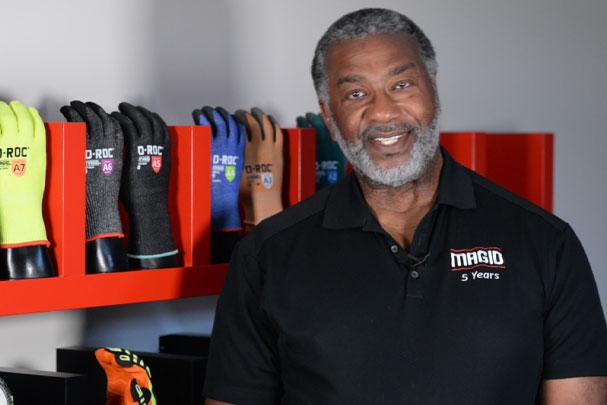
Choosing the Right Face Mask for Your Workers
For the foreseeable future, many workers will have to wear a face mask in addition to their usual PPE. Ideally, you’ll want to find one that’s comfortable to wear throughout the day, follows CDC guidelines, and won’t take too big a bite out of your budget. While the right choice depends on your jobsite’s needs and regulations, the good news is there are several popular masks at different price points to choose from for your workers.
Disposable Masks
Per unit, disposable face masks usually cost less than reusable masks and can be discarded after use rather than being washed. However, this also means that workers can go through masks quickly throughout the workday and deplete your stock over time, potentially costing more money in the long run.

MM005
MM005’s offer at least two layers of respiratory protection, with most models featuring a third layer of melt-blown polypropylene that is woven tightly to capture smaller particles. Some may also include an adjustable nose clip that prevents eyewear from fogging.
- Protection: Two-Way (Droplet Only)
Wearing a disposable MM005 mask protects you from spreading large nose and mouth droplets to others and prevents droplets, sprays, and splashes from directly reaching your mouth and nose. However, medical masks are loose fitting and are not designed or recommended for protecting you from smaller airborne contaminants. - Antimicrobial Coating: None
- Comfort Factor: Some are made with an inner liner of non-woven polypropylene as well as two stretch ear loops to create a better, more comfortable fit.
| Cost | Layers |
|---|---|
| Lower-Cost | 3 |

N95
FDA-cleared N95 respirators are regulated under FDA requirements (21 CFR 878.4040) and NIOSH requirements (42 CFR Part 84).
- Protection: Two-Way (Airborne and Droplet) (One-Way with Respirator Valve)
A properly fitted N95 respirator mask is designed to reduce exposure to approximately 95% of small airborne particles and large droplet contaminants down to .03 microns through its tight-fitting seal around the nose and mouth. Some N95 respirators include an exhalation valve for easier breathing and to help reduce moisture and heat build-up. While these masks provide the same level of protection to the wearer as their valve-less counterparts, exhalation valve respirators should not be used in environments where the air-quality must remain sterile. - Antimicrobial Coating: None
- Comfort Factor: N95 masks possess stretchable straps to help secure a proper seal around the wearer’s head. This seal is created via a crown and neck strap to create a tighter fit compared to other masks with just ear loops.
| Cost | Layers |
|---|---|
| Higher-Cost | 1-4 (Depending on the Model) |
Reusable Face Masks
Unlike disposable masks, reusable masks can be laundered multiple times, making them more cost-efficient per use over time than disposable masks. The CDC recommends that cloth face masks include multiple layers of fabric to create a stronger barrier against common viruses.

Cloth Face Mask
According to experts, cotton has some of the best fabric filtration abilities because of its tight braid and rough fibers that can capture tiny particles better than certain man-made fabrics.
- Protection: One-Way
- Antimicrobial Coating: Cloth face masks often include an antimicrobial finish, sometimes containing elements like copper and silver. While antimicrobial treatment can help the mask from becoming contaminated with germs, the treatment will wash off after considerable use. Although copper alloys do have antimicrobial properties that fight various types of bacteria, more testing is needed to determine its effectiveness combating COVID-19 and other viruses.
- Comfort Factor: Soft cotton ear loops increase comfort against the skin while snug yet soft fabric allows for breathing without restriction.
| Cost | Layers |
|---|---|
| Lower-Cost | 3 |

Flame Resistant Face Covering
FR face coverings can possess odor control properties and are meant for workers in oil, gas, chemical, and electrical utility industries.
- Protection: One-Way
- Antimicrobial Coating: Although it is arc flash rated and possesses a moisture-wicking ability, this mask does not include an antimicrobial coating.
- Comfort Factor: An FR face covering’s fabric is lightweight and breathable while remaining inherently flame-resistant.
| Cost | Layers |
|---|---|
| Mid-Range | 3 |
Other Face Coverings
The CDC says that masks made of two or three layers of cloth material can be used as a face covering in the absence of a standard mask. A face covering should fully cover your worker’s mouth and nose, fit snugly against the sides of their face to minimize gaps, allow for breathing without restriction, and be secured or tied to prevent the mask from slipping off of the face.

Cooling Neck Gaiters
Gaiters are considered multi-purpose items that can be worn multiple ways with added benefits like cooling. Cooling neck gaiters can be folded onto the face in two- or three-ply layers for a face covering that can keep workers more comfortable while also blocking large dust and debris particles.

| Step 1: | Put the gaiter over your mouth and nose |
| Step 2: | Pull the bottom of the gaiter down |
| Step 3: | For a Two-Ply covering: Grasp the bottom of the gaiter and pull it up and over the first layer For a Three-Ply covering: Pinch the middle folds of the gaiter and pull the additional two folds over the first layer |

Add-On Protection
A full face shield can provide liquid splash protection in addition to the respiratory protection of wearing a mask. Full face shields often use a .2 mm thick polyethylene terephthalate (PET) shield or anti-fog coating.
Get the products you need to keep everyone working safely
GO TO COVID HQ







